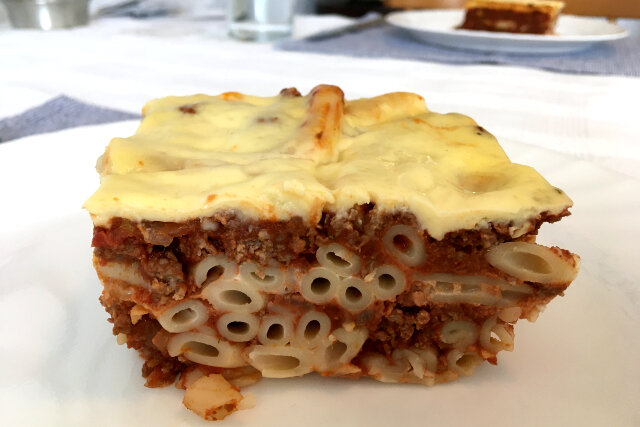Patient Pastitio Adventure
On a winter hiking trip in high school, I struggled to ascend the steep trail, sweaty and red-faced with an overstuffed pack. An older student saw me falter. She positioned herself directly in front of me and set a slow, methodical pace. Step, breathe, step, breathe.
With everything happening now, that old impatience is resurfacing. I want us, as a people, to get there already — the virus vanquished, systemic racism and bigotry excised, the environment restored, good defeating evil. Our packs are so full.
I realize that this might feel a bit heavy for a fun little food blog. *Takes a deep breath.*
You know what else is heavy? Pastitio.
The gut-busting full-fat noodle dish, sometimes called “Greek lasagna,” has also been on my mind a lot lately. It typically has a rich meat sauce and grated cheese topped with a layer of béchamel. Simply lifting the pan requires Papou-level strength. My earliest memories of it were the restaurant-sized trays for the local church’s Greek festival in July.
Like many Greek casseroles, pastitio isn’t a one-bowl situation you can make for dinner on a whim. It requires careful planning, shopping, chopping, stirring, simmering, whisking, multi-tasking. And a working oven.
Ours was broken for most of the spring. Guillaume spent hours on the phone with the behemoth pulled away from the wall. At one point he talked to a lady who had roosters crowing in the background. He navigated the opaque appliance manufacturing bureaucracy and finally solved the mystery. Please don’t ask me how. I’m just deeply grateful that it works now.
Despite the soaring summer heat, pastitio went to the top of my food list. The dish has the advantage of being easy to portion and transport. At home it fills our largest glass baking pan — perfect for sharing. Alyssa’s modest no-contact food delivery service, if you will.
The recipe below is our family’s adaptation of the church version. Although I haven’t made a vegetarian version yet, using pinto beans instead of meat in the sauce should work since the base is so similar to moussaka. Feel free to swap out Parmesan for a sprinkle of nutritional yeast. The dried pastitio noodles I use come in multi-packs from Greece and keep forever, but ziti, rigatoni, or a similar tube-shaped pasta is fine.
Traveling around town giving away extra pieces of pastitio safely at a distance brought me joy. All those small steps put together felt worthwhile. Whatever mountain of a dish is on your list, I hope you get there, too.
Danigelis Pastitio
Filling:
2 lb. 92% lean ground beef, highest quality
¾ C. chopped onion
1 clove garlic, minced
Can crushed tomatoes, unsalted 28 oz.
Can tomato sauce, unsalted 8 oz.
1 small can tomato paste, 6 oz.
1 cinnamon stick
¼ C. Italian parsley, minced
¾ C. red wine such as a Burgundy
Salt and pepper to taste
In a large saucepan, brown the meat until no longer pink, then add the onion and garlic. Cook until onion is translucent. Add the remaining ingredients plus freshly ground black pepper, 1 teaspoon salt, and continue simmering. Take the cinnamon stick out after 20 minutes. Simmer sauce 1 hour or until it’s thick. Set aside to cool. Taste and adjust the seasonings. Should not be bland.
At this point you can let the sauce cool and refrigerate it to assemble the dish later. The sauce can be frozen for later use, too.
1 lb. ziti noodles or 500g dried Greek pastitio pasta
Parmesan cheese, approximately 1.25 oz.
4 large eggs, separated
3 C. whole milk, slightly warmed or at room temp
6 Tbsp. salted butter
5 Tbsp. flour
½ tsp. salt
Freshly ground pepper
Cook pasta in salted boiling water for 2 – 3 minutes longer than the instructions indicate. This sounds wrong but it helps the dish meld. For the Greek pasta, use long tongs to gently bend the tubes away from you into the pot until they’re covered in water. Be careful — they can spurt boiling hot water!
Separate the eggs.
Drain the pasta and run it under cold water. In a large mixing bowl, dab the pasta dry with a paper towel and then mix in the egg whites, coating well.
Finely grate the Parmesan.
Make the béchamel: Melt the butter in a large saucepan over medium heat. Whisk in the flour and cook for a minute until golden brown. Off-heat, very gradually mix in the milk. Then return to the burner to cook, stirring constantly, over medium heat until thick. Be patient. This could take a long time. Should be a spoonable consistency. Add the salt and pepper. Remove from the heat. Wait a few minutes for it to cool slightly.
Beat egg yolks well in a bowl then very, very slowly add them to the béchamel sauce. Avoid cooking them.
Preheat oven to 350°F.
Assemble the casserole: Put half the pasta in a 10x15-inch baking dish. Add half the meat sauce and sprinkle on the Parmesan. Add the rest of pasta, then the second half of the sauce. Smooth the sauce with a spatula or the back of a large spoon. Carefully spoon béchamel evenly over the top.
Bake for 1 hour or until the béchamel is bubbly, browned, and set. It’s okay to leave it in for longer. Remove and let cool for at least 15 minutes before cutting into squares to serve. Goes well with a lemony Greek salad.
Allow leftovers to cool completely before refrigerating. Re-warm in the oven or microwave covered at half-power in 3-minute intervals.



